The majority of this story was written during the evacuation of Calistoga during the 2020 Glass Fire.
Sept. 27, 2020. Pre-dawn
A faint orange glow radiated within the window's dark frame of night purple. I took a deep breath and recoiled. Obscuring the now normal odor of stale wildfire smoke that had become a permanent feature of our home was the acrid aroma of burning trees and singed brush combined with another unforgettable smell of active wildfires — something vaguely reminiscent of scorched hair. Next to me my wife lay sleeping, her expression peaceful and unaware. If I didn’t wake her she might get a bit more rest before we needed to flee.
I got out of bed quietly and tiptoed to the window, where I pressed my head against the cool glass. The flames remained a few miles away from our Napa Valley home in Calistoga, but a gusty wind had shifted in our direction.
“We still have time,” I thought.
I dressed quickly and grabbed a few of my cameras, my neon-green safety vest and a headlamp before slipping out of the house. As I drove south down Highway 29 the glow pulsated ahead as a tower of smoke and flames filled more and more of my windshield.
Chasing fire
As a photojournalist in Northern California’s Napa Valley Wine Country I often find myself documenting tragedy — the impact of the coronavirus pandemic on businesses within one of California’s premier tourist destinations and the overwhelming disparity of two classes, the ultra-rich and all the poor who serve them. I have also explored the environmental impact of the modestly sized Napa County — roughly 500,000 acres, or about the size of Jacksonville, Florida — that grows a single crop — wine grapes — and observed what happens when 4 million tourists visit a small community with a population of roughly 100,000 each year.
My role is to inform the public by recording what happens in this special place, which often means highlighting through words, photos and video the pervasive beauty, generosity and tenacity that the people and nature here often display. A decidedly darker side also resides here: a brazen greediness, a lack of awareness of others or for the environment, and a distinct type of surfeit-luxury consumerism — endless-course meals, multimillion-dollar third homes and ostentatious wine events — that is often repulsive when viewed from afar but can be seductively euphoric when one is included.
No matter what my assignment, I am surrounded by the stunning beauty of pastoral landscapes softened by a copious supply of expensive architecture and infrastructure in what has become a manicured playground for the privileged. And while each season has its own allure, the most active and enticing time of the year by far is August through the end of October, or what is typically referred to as “harvest season.” The meaning of this simple catchphrase has changed in the last few years, however, and today many call this particular time of year “fire season.”
Until very recently fires were less frequent in this region. However, like in many of the globe’s more temperate and Mediterranean areas, climate change — exacerbated by a burgeoning population, droughts and a lack of effective forest management — have led to uncontrollable wildfires that now rip through the region almost annually.
We are all becoming too familiar with the stark imagery of these firestorms — the pictures of towering pillars of twisting flames that rage skyward as tinder-dry landscape from years of drought explodes as if doused with gasoline. Eventually these initial impressions are replaced with somber pictures of the white-ash rubble of incinerated homes, burned-out businesses, flattened forests, and the littered remains of destroyed livelihoods and lives.
In 2017 the Tubbs fire, which ignited a few city blocks from our home, ravaged Wine Country, taking 48 lives, destroying more than 4,000 homes (nearly 5% of the housing stock), gutting more than 1,000 businesses and costing the local economy $1.2 billion in the short term. Longer-term estimates suggest a cost of over $10 billion. It’s hard to affix a final number on the cost because the rebuilding from that fire is still far from complete, with many of those impacted having already left the area to seek more stable environments in which to live and work.
A fire as large and devastating as the Tubbs Fire hadn’t occurred in the area for more than 50 years, but each year since, wildfires have had a negative impact on Northern California communities and their wine industries. The effects of these fires don’t end with the burnt buildings, savaged vineyards and ruined infrastructure. Smoke from distant fires can settle on pre-harvested grapes and lead to unpleasant flavors in wine. Called “smoke taint,” the chemical compounds that result from this unholy matrimony are not necessarily harmful if ingested, but they are undesirable. The aroma and taste are more akin to licking an ashtray than to, let’s say, smelling a hint of toasty oak in your wine.
In 2018 smoke from the Mendocino Complex Fire (the biggest in the state’s history until this year — 459,000 acres) settled on the region from late July to mid-September. This was followed by an even thicker blanket of smoke in November from California’s most deadly fire, the Camp Fire, where 85 perished and 18,804 structures were destroyed at a cost of over $16 billion in property damage. Estimates suggest that the total cost of California wildfires in 2018 was somewhere over $400 billion. This year’s conflagrations will likely cost the state even more.
In 2019 the Kincade Fire struck eastern Sonoma County again only a few miles from our home, covering the town with ash and smoke for weeks during the end of October and early November. And 2020 has been even worse. By mid-October nearly 9,000 different fires had consumed more than 4 million acres throughout California — roughly 4% of the entire state’s landmass or more than the entire state of Connecticut. In particular, from August through October two fires — the LNU Complex Fire and the Glass Fire — had burned thousands of acres, dozens of vineyards, and hundreds of homes and businesses in and around Napa County.
The 2020 Glass Fire ravaged the area, burning more than 67,000 acres and destroying over 1,500 structures, including 308 homes and 343 commercial buildings in Napa County, as well as 334 homes in Sonoma County. The costs have run into the billions, and the impact from exposure to smoke from this fire and others has resulted in exacerbated pulmonary injury and disease. As a result of fire after fire in the region, many insurance companies in the area have either raised the cost of coverage to price out most county property buyers or dropped coverage in California altogether, many citing the Glass Fire as the last straw.
Additional issues beyond the fire, smoke and ash plague the people who live here when fires hit. If the threat of a fire rears its ugly head the power is often shut off as a precaution. Although many of these fires’ causes are still under investigation, we already know that several of them were ignited by failed power lines during high-wind events. Northern California’s power supplier — Pacific Gas and Electric, citing over $30 billion in liabilities, filed for bankruptcy in 2019 and eventually pled guilty to 84 counts of involuntary manslaughter in the deaths of Camp Fire victims. Since then the company has adopted an aggressive public safety power shutoff policy. During PSPS events PG&E turns off power to homes and businesses in fire-prone areas of California when high winds and hot weather are predicted. In 2019 Calistoga endured weeks without power during the height of the harvest season. Because these outages come in two- to five-day increments, each is accompanied by no air conditioning during sweltering heat, rancid food from failed refrigerators, limited internet access, wineries without the power to complete winemaking, and stalled businesses and lives in what becomes a painful and costly cycle.
My wife and I are not poor, but we are certainly not rich. We have neither a second home nor an RV. Our geriatric cat — and at the time of the Glass Fire, our 65-pound Australian Shepherd -- combined with my wife’s immuno-compromised condition and my own pulmonary challenges due to wartime service in the Persian Gulf and years of chasing fires, make hotels and staying with friends and family challenging enough in normal times but was almost impossible during the pandemic.
We are not alone as millions of weary wildfire evacuees cram whole families into acquaintances’ extra rooms or live out of tents or cars as they wait days for hotel vouchers. And we are all the lucky ones who haven’t lost our homes to fire. Families with children are especially challenged — closed schools and no consistent access to the internet brings another source of apprehension for an already fearful generation. The end result of this repeating cycle is a growing sense of dread any time the wind picks up or when we detect even a hint of the once-pleasant aroma of harmless campfire smoke. No wonder the doctors can’t figure out if my recently acquired breathing difficulties are due to smoke inhalation, anxiety or both.
Wine Country businesses are dependent on a single industry — at least 44% of jobs in the area are wine-industry related. When the COVID pandemic hit, the occupancy rate at Napa Valley hotels dropped to a record low of 12%. By early August that had recovered somewhat to 50% but was nowhere near the normal of 80% to 90% for that time of year. Being a tourist destination focused on the consumption of wine means that those who visit spend lavishly on fine dining, luxury resort stays and possibly even a hot-air balloon ride, but that wouldn’t happen this year.
The businesses that had survived to midsummer 2020 — many resorting to adding more debt, GoFundMe campaigns or surviving at a loss for those who could — had all hoped and prayed for a fireless harvest. They envisioned the historic uptick of visitations, the loosening of purse strings and a needed celebratory atmosphere of survivors. But then the first fire came and then a second. Consistent access to power became uncertain. Smoke drifted in from both nearby and hundreds of miles away. Grapes were left on the vines unharvested. Many workers, whether unable to find consistent work or because of the fear of unhealthy working conditions, left the area.
The tourists stopped coming — again. Restaurants, wineries and tasting rooms, once normally cacophonous collections of well-dressed patrons, were now empty or frequented by a different type of adventurer. Exhausted parents from the nearby San Francisco Bay Area who were seeking a few hours of peace and quiet replaced the ultra-rich seeking exclusivity and luxury.
Most visitors now came for the day, grabbing a sandwich at Gott’s Roadside hamburger stand in St. Helena instead of having an hours-long meal at the world-famous French Laundry in Yountville. Few seemed interested in purchasing a $200 bottle of wine when instead there were less-expensive options available. Some decided to forgo wine altogether, opting for a cold beer instead.
September 27, 2020, 5 a.m.
As I drove that smoky morning I passed lush green vineyards, their vines heavy with ripe grapes ready for harvest. A few early morning commuters were stopped along the highway to gape at the scene unfolding. The fire — now a vivid inferno of burnt orange on the horizon — was like a much-too-early sunrise, penetrating everything around it, including the billowing tower of clouds above, and making the entire scene look like volcanic lava flows.
I checked my watch. My wife would be waking soon. I’d snap just a few photos and then head back.
As I turned a corner, I was reassured. Up the winding road to my right was the $40 million re-created 13th-century Tuscan Castello di Amorosa and perched on a hill in the center of the valley to my left stood the iconic Sterling Vineyard. I didn’t know it at the time, but by the next day both would be severely damaged by fire.
I pulled over and stopped my truck.
Two signs welcome visitors to the Napa Valley. Both are along Highway 29 and both have become beacons for those seeking to capture proof of their trip to California’s Wine Country. One is north of Yountville, and the other is just south of Calistoga. On most normal days each of these signs is surrounded by throngs of cars and tourists snapping selfies, each attempting to capture his or her smiling face alongside the billboard with its message from beloved Scottish poet Robert Louis Stevenson that “Wine is bottled poetry,” all framed nicely with green rows of neatly groomed vineyards that fade into hazy-blue hills in the distance.
But that morning, as if an allegory for our times, the iconic billboards were now backlit by a raging wildfire.
The fire was moving fast, but it was blocked from where I was parked by a vineyard, which can act as a firebreak. I jumped out of the car, set up my cameras and started snapping. Within an hour the fire had jumped to another ridge and slipped down the mountain toward the valley’s edge. Even in the pale morning light the many dark plumes of smoke signified that a home or other structure had been consumed.
Cars continued to pull over, the drivers stepping out, their expressions a mixture of horror and awe at the strange beauty we were witnessing. Few spoke. After a few minutes most jumped back in their cars and sped off.
A woman approached. She wore a mask and leaned close.
“Not sure we can take any more of this,” she whispered, shaking her head.
I just nodded.
She remained still and silent for a few minutes, her shoulder almost touching mine until she turned without a word and then jumped quickly into her car. Hesitating, she headed south but then made a quick U-turn and drove back toward town.
I pulled out my phone and dialed.
“Honey,” I said.
“Good morning,” she said, her voice muffled by sleep.
“I need you to pack and get the pets ready to go,” I said.
There was a long pause as she processed what I was saying.
“I smell the smoke,” she said in resignation.
I stood holding the phone to my ear and watched the fire as it spread down another mountainside, its flames leaping what seemed like football-field lengths as the wind drove it forward. One thick black wisp of smoke was followed quickly by another.
“I’ll be home soon,” I said.
A fire truck roared past. Although I couldn’t see inside the darkened cabin, I imagined that it held a crew of exhausted and fire-weary firefighters heading out into uncertainty yet again. They’d been away from their families for weeks, some even months, all risking their lives for the safety and well-being of others.
I considered saying goodbye to my wife and hanging up. I needed to collect my cameras and get back on the road, but instead I waited.
“Do you think we will be OK?” she asked.
My throat tightened. I wanted to tell her that I didn’t know. I didn’t know how we might survive and thrive in a world where there seems no safe place to go.
“Yes, we will be OK,” I finally said, “but we have to go now. The wind is picking up and the flames are moving fast.”
Tim Carl is a Napa Valley-based photojournalist.


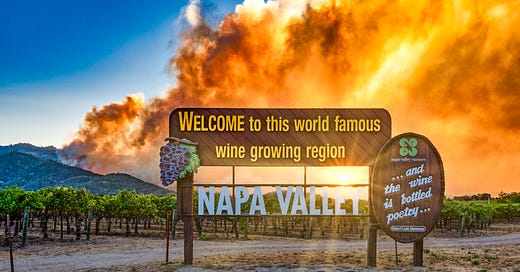



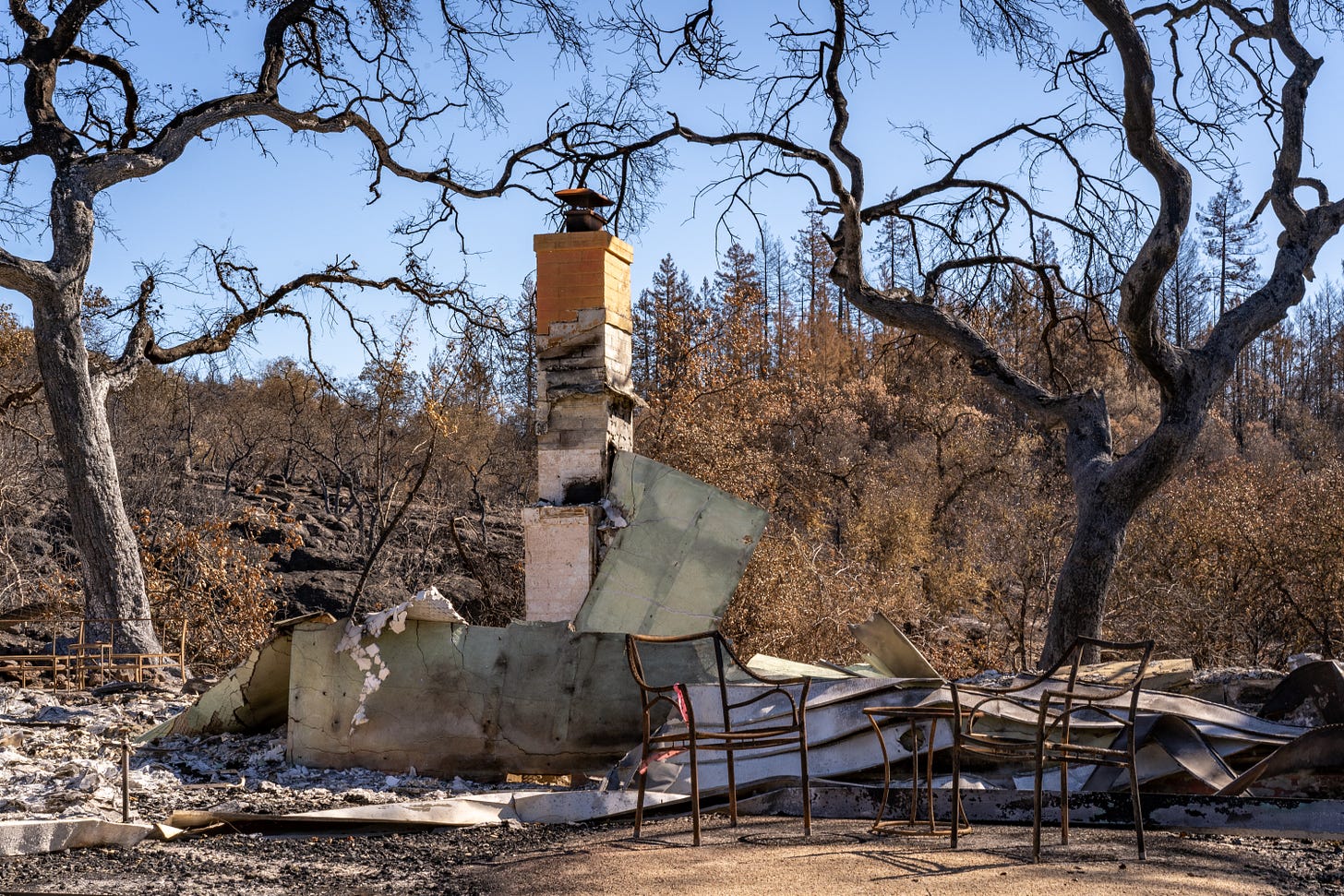
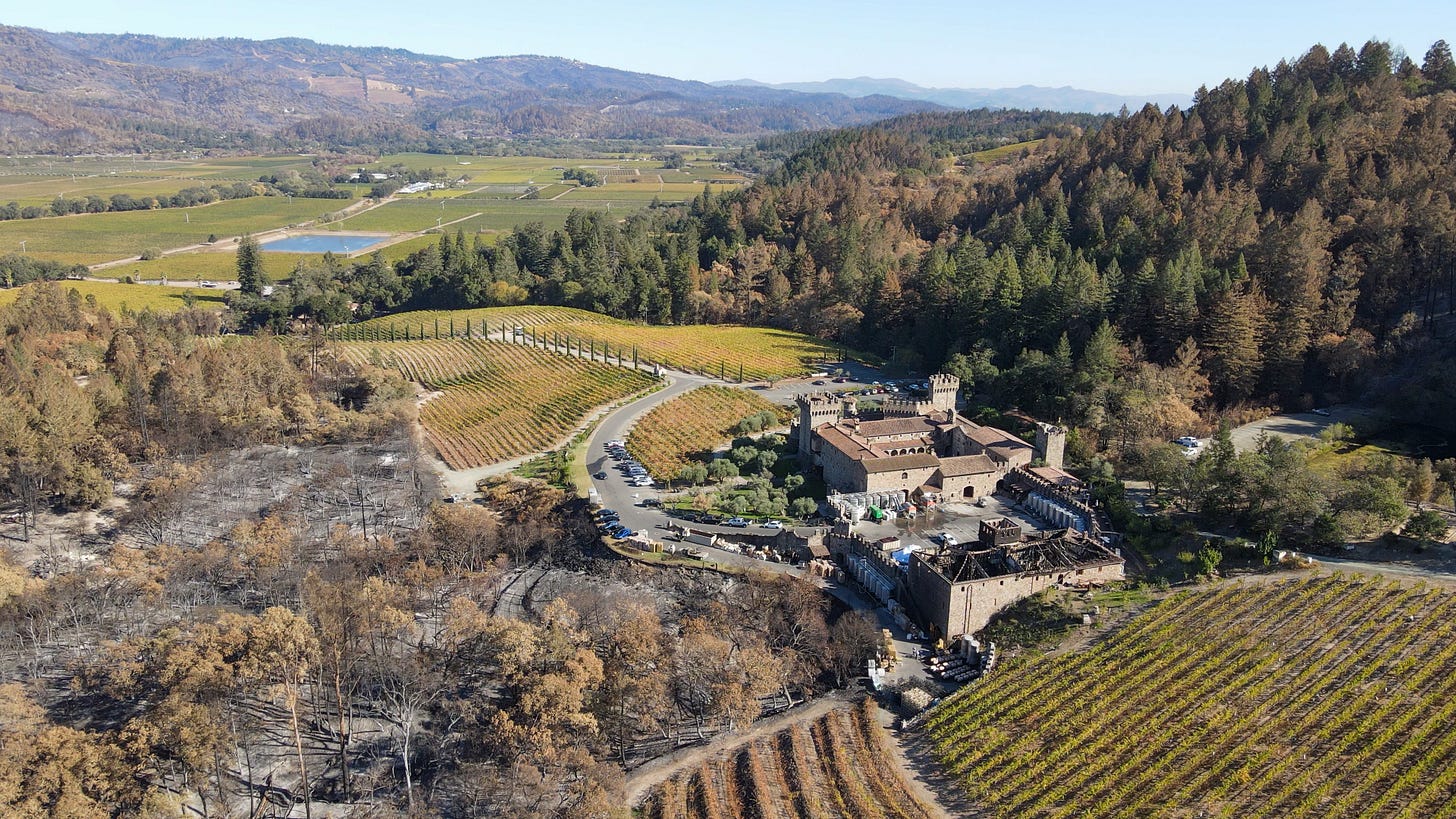
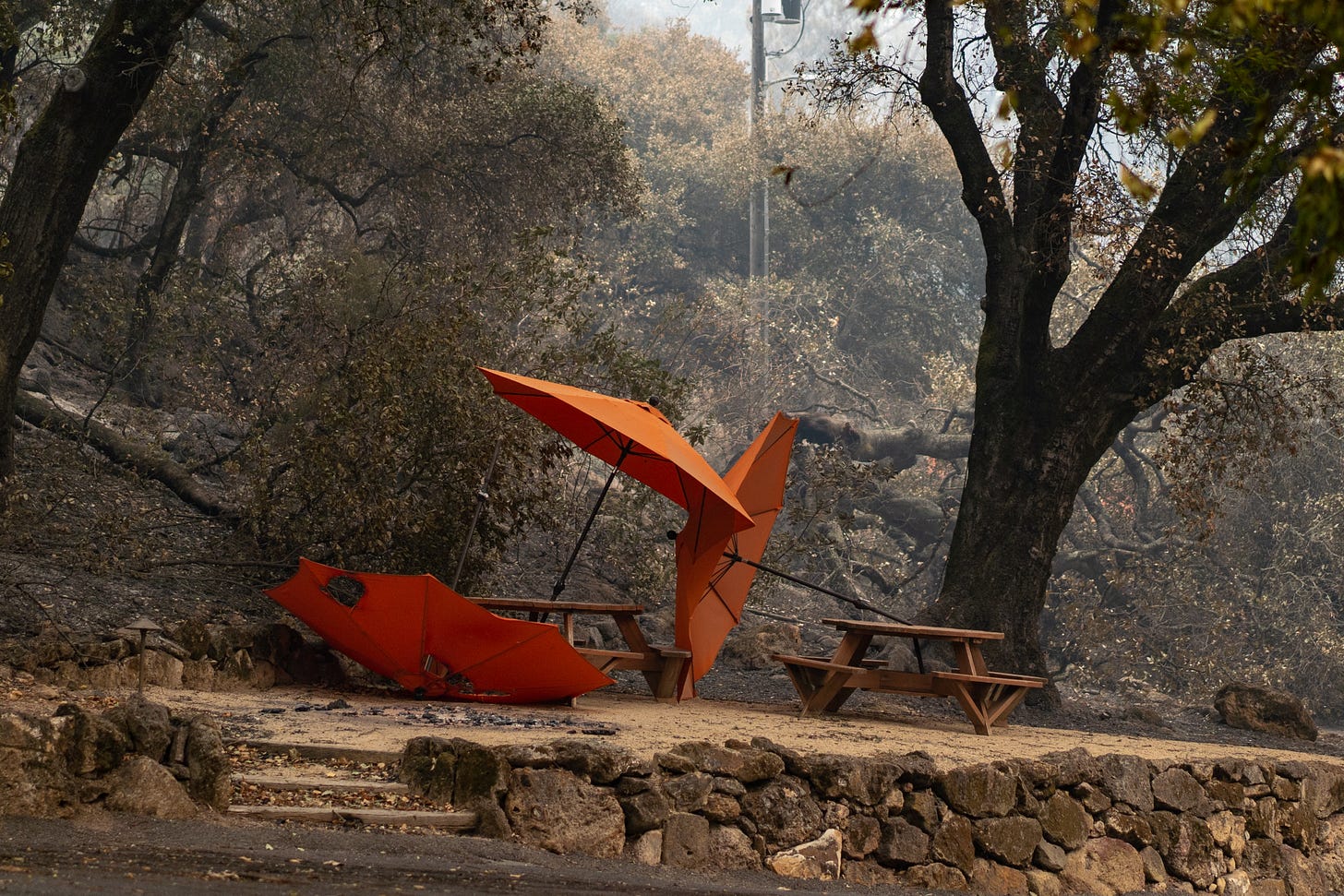
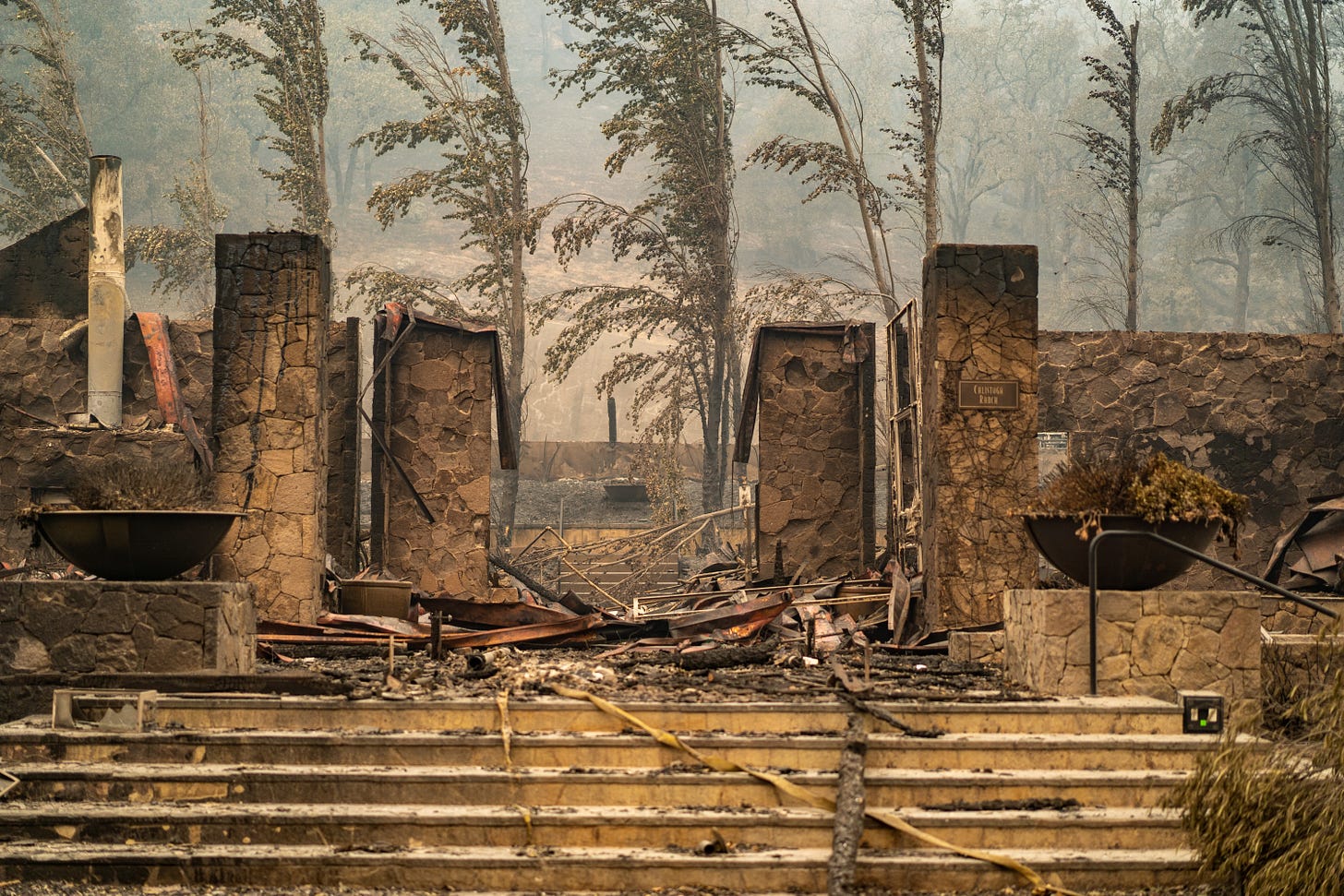
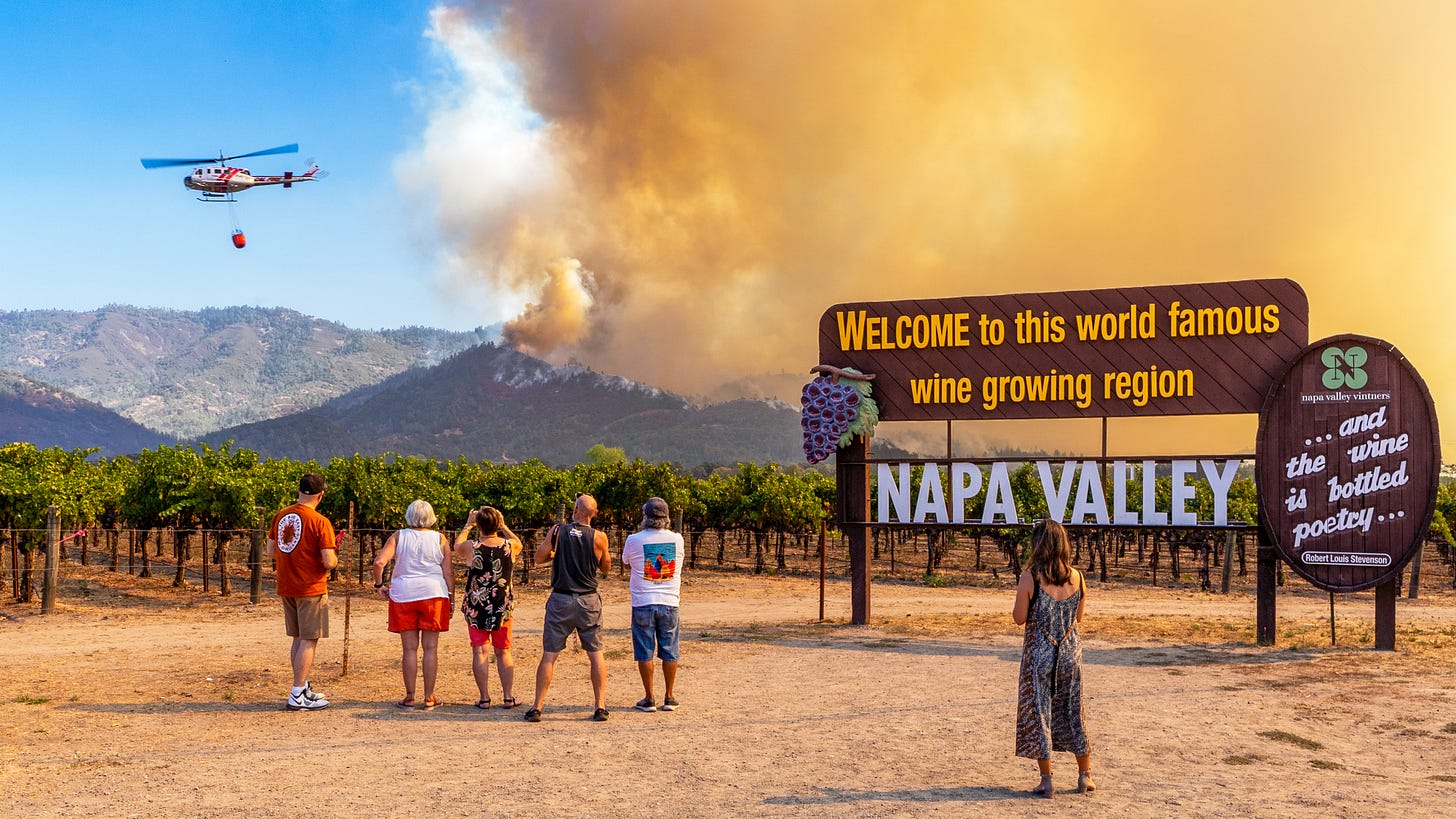
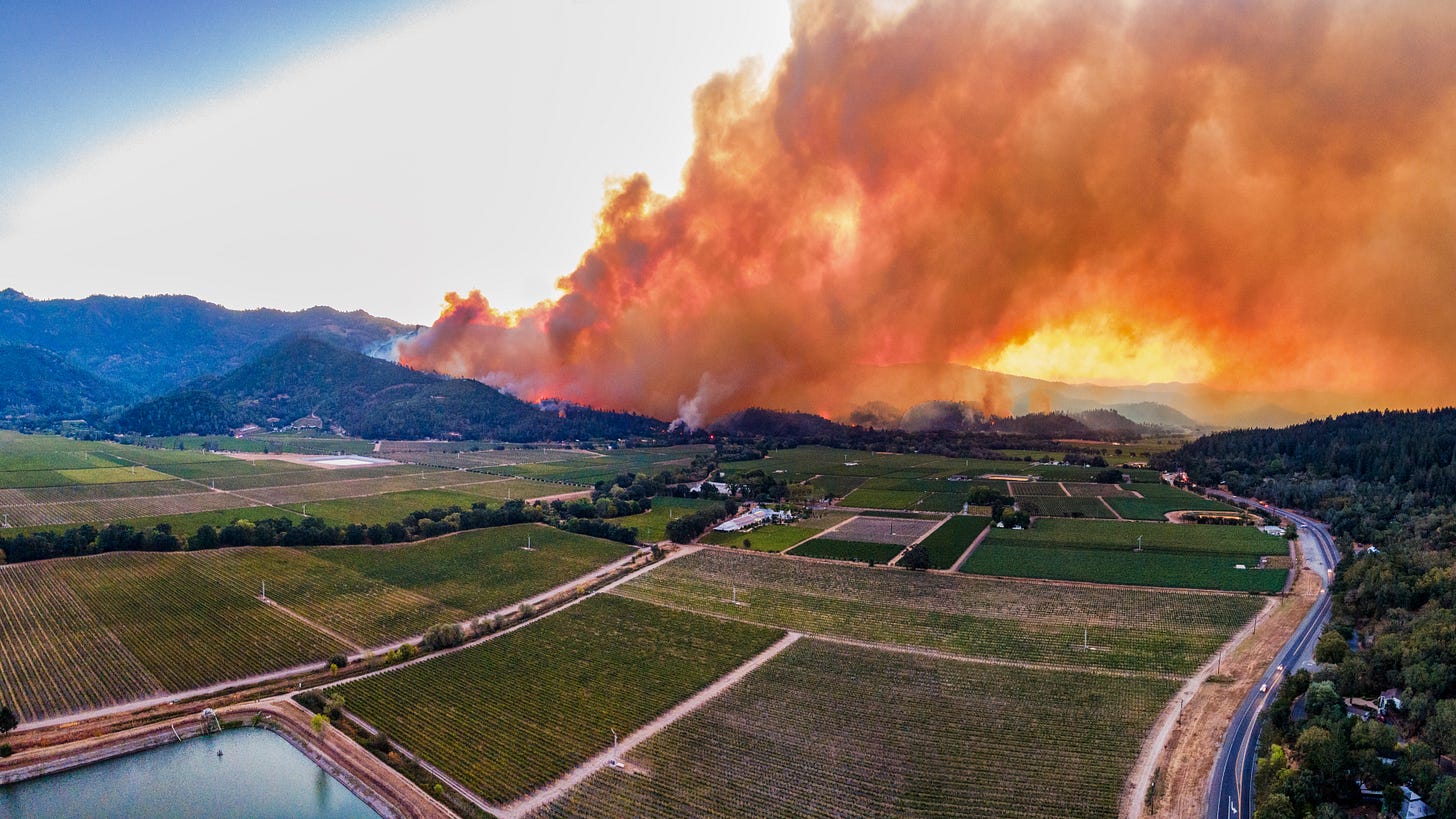
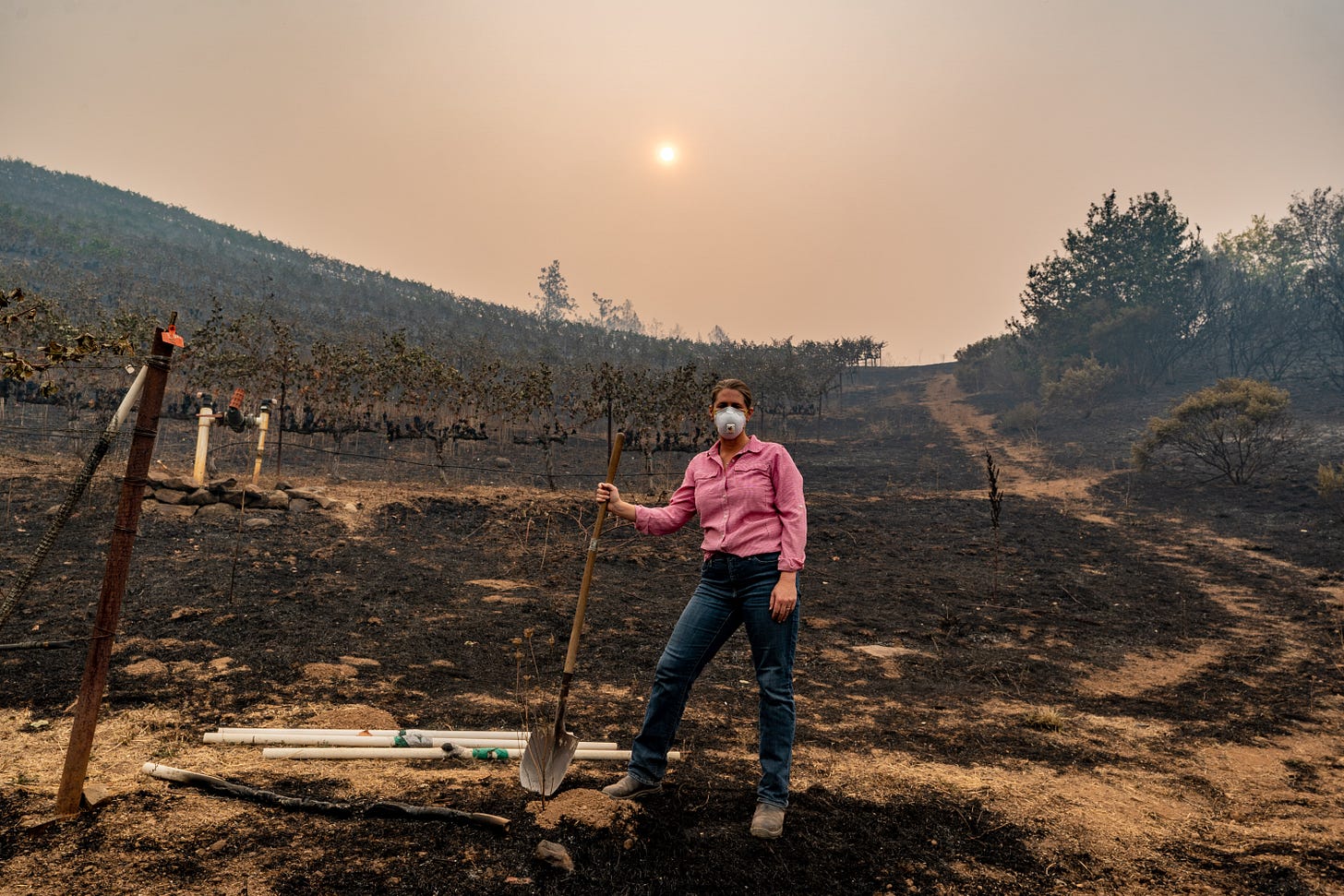
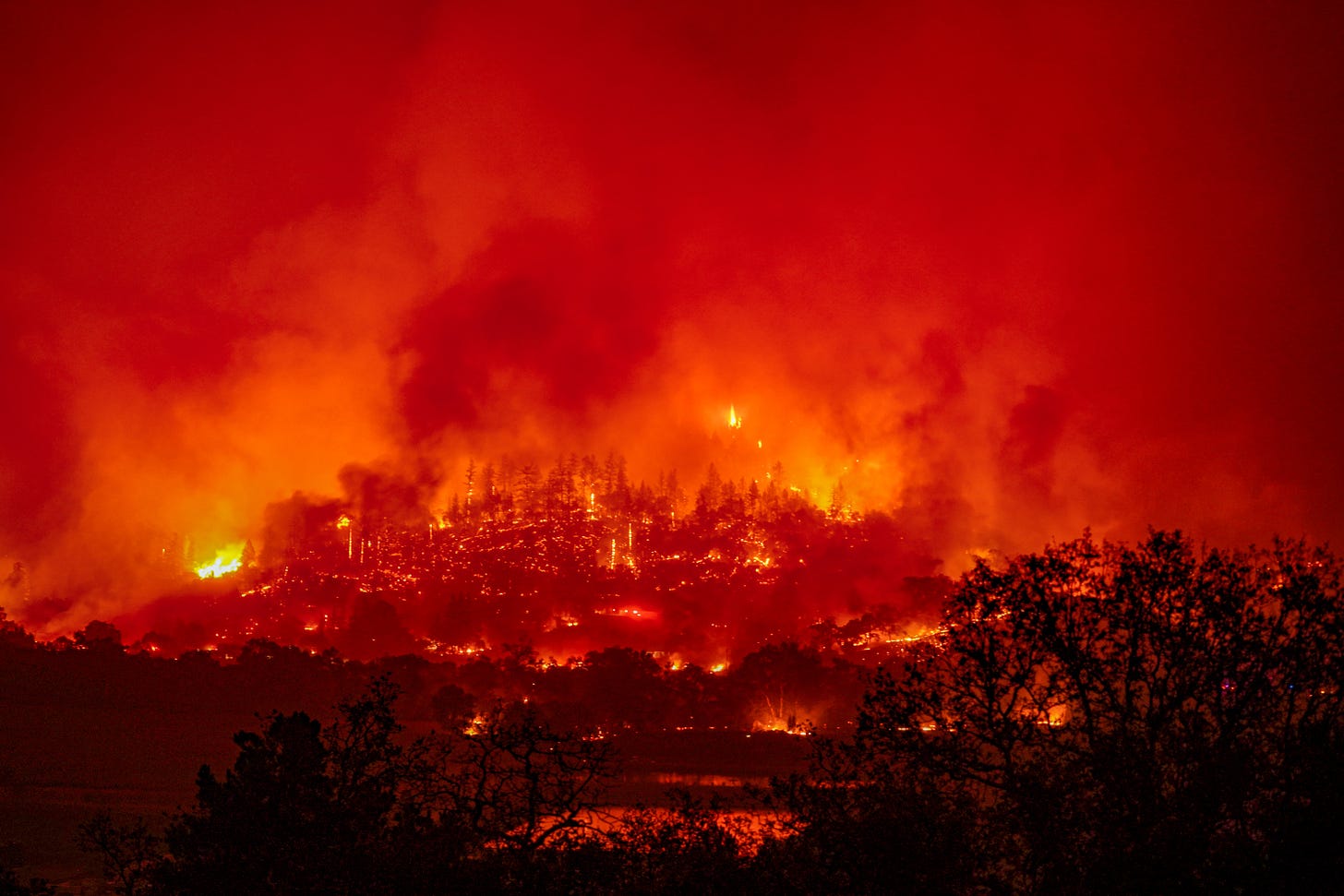
It’s hard to say “wonderful” about anything to do with a terrifying experience, but your photographs and writing are wonderful. Your critique of the “Napa Valley Lifestyle” is perfect, too. So much hard work by so many people goes into that, and it’s invisible to most visitors.
Well done, Tim.